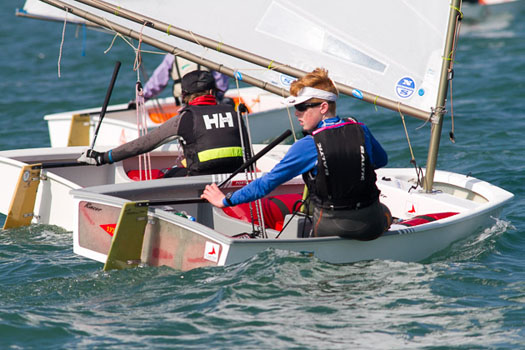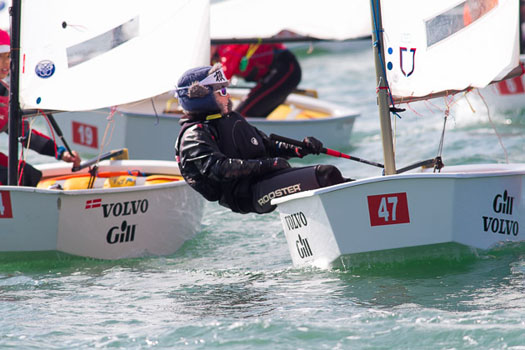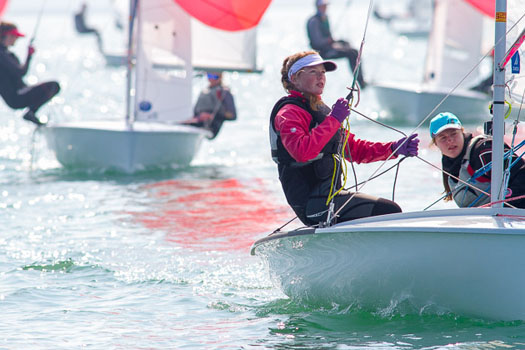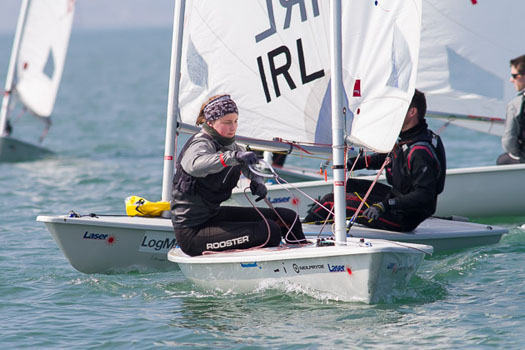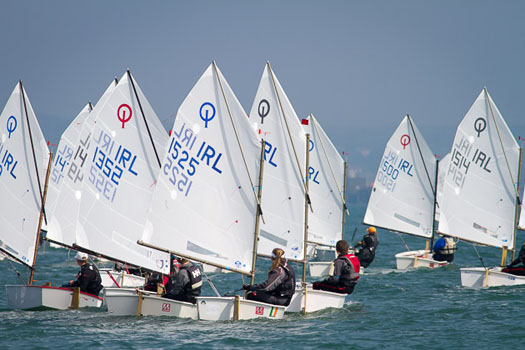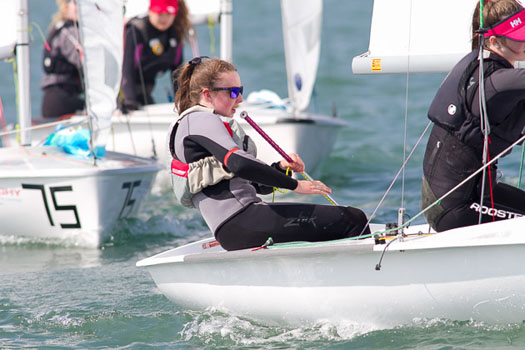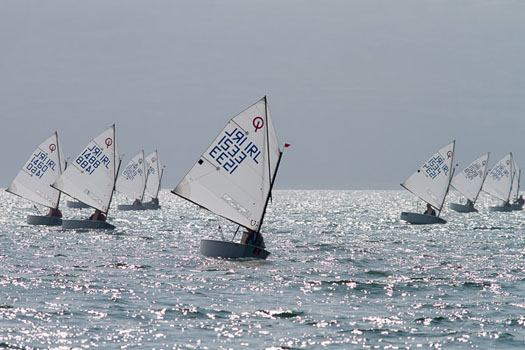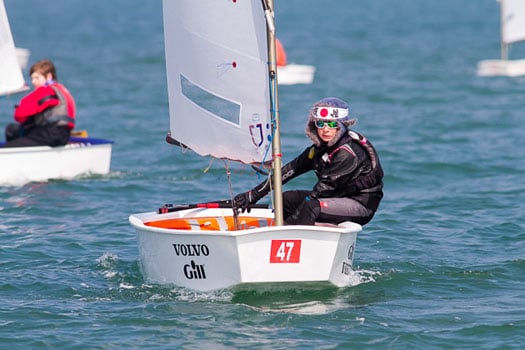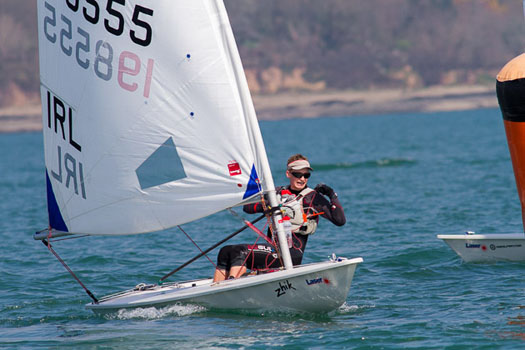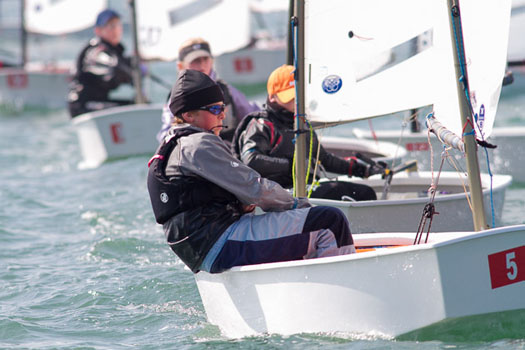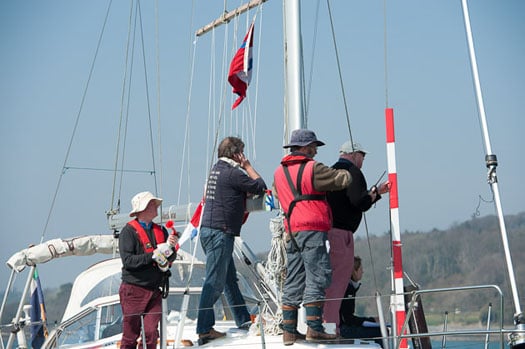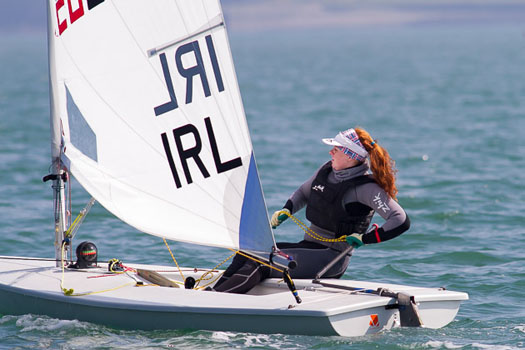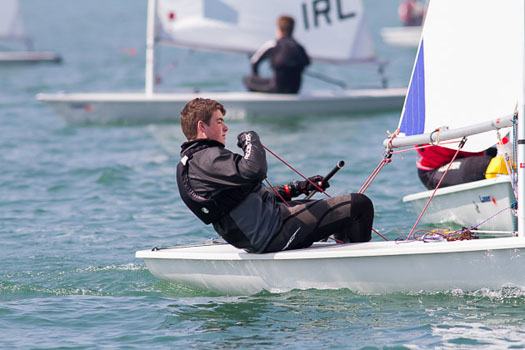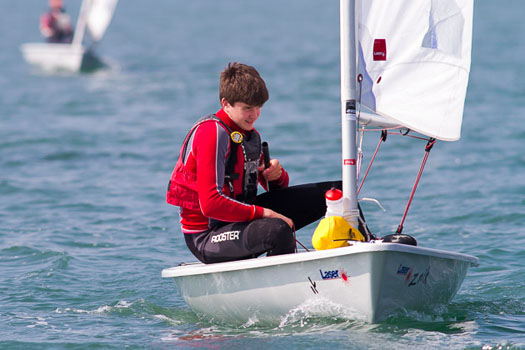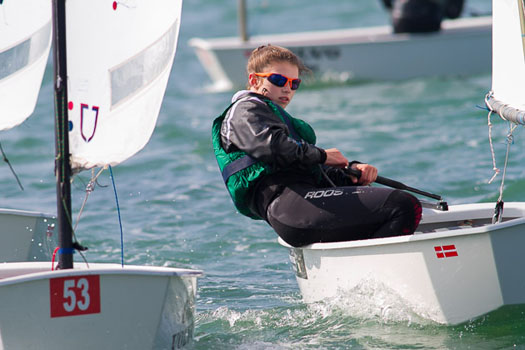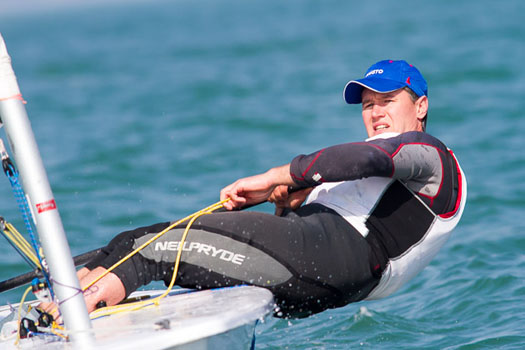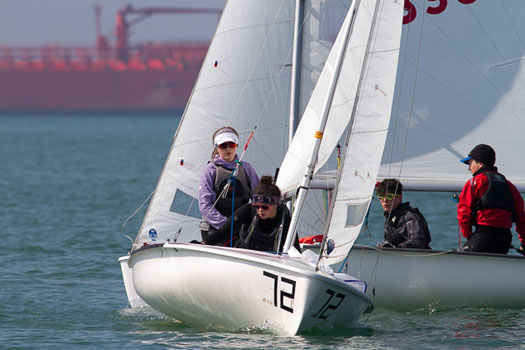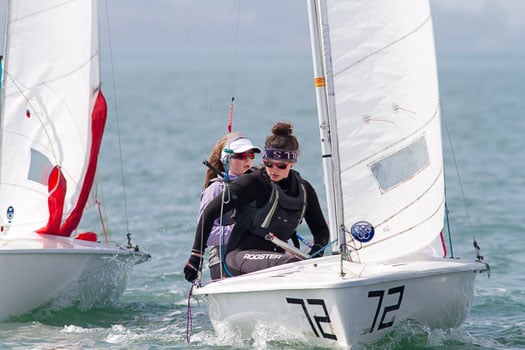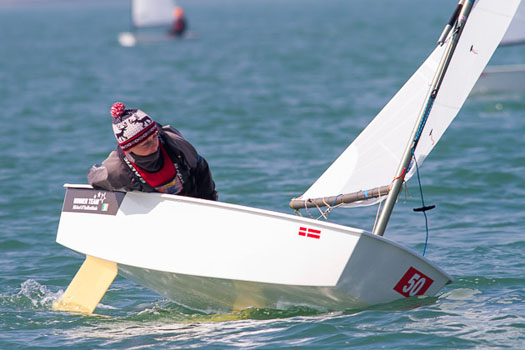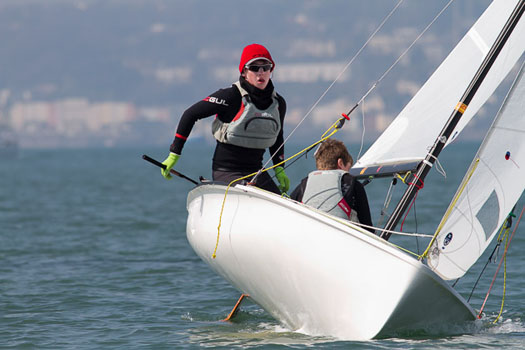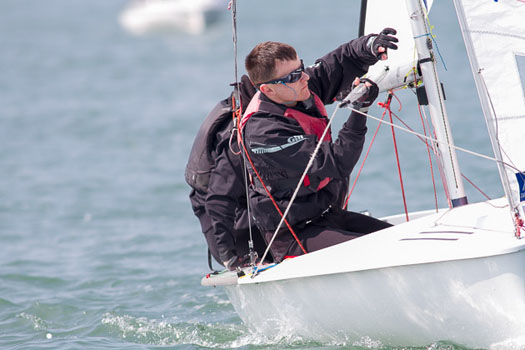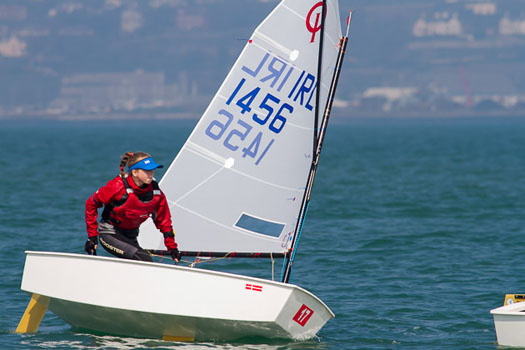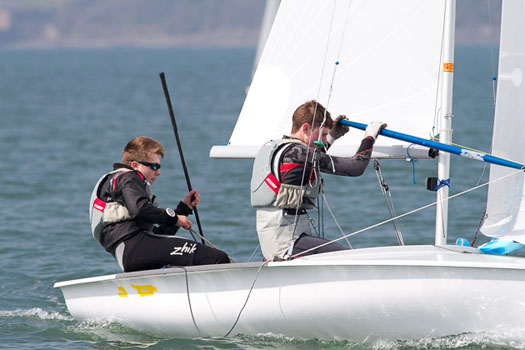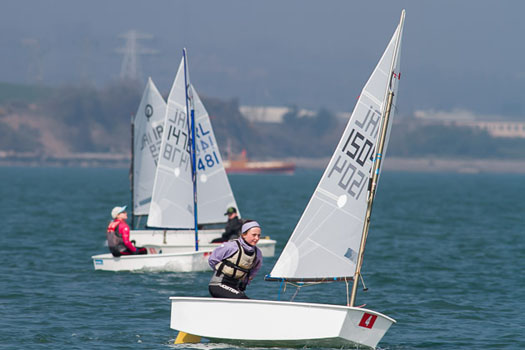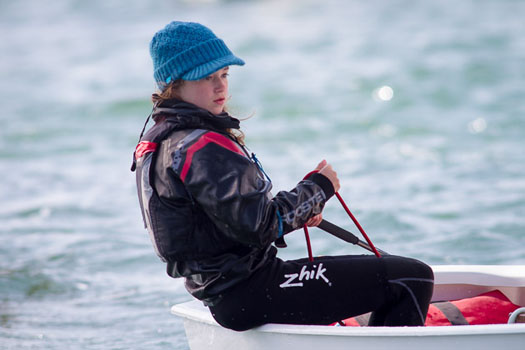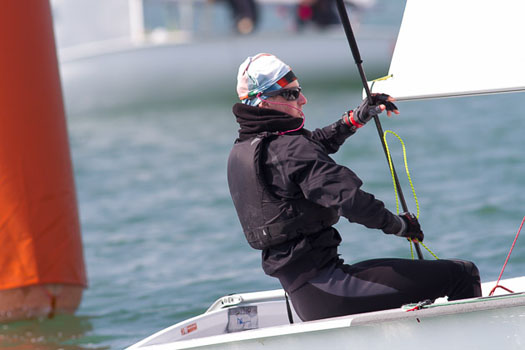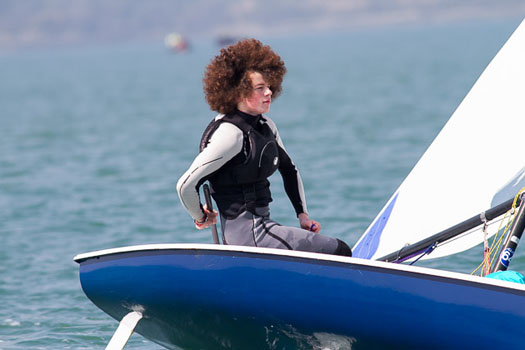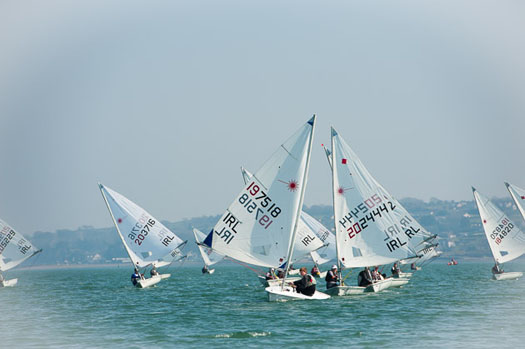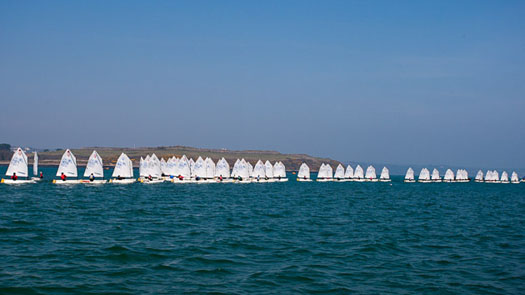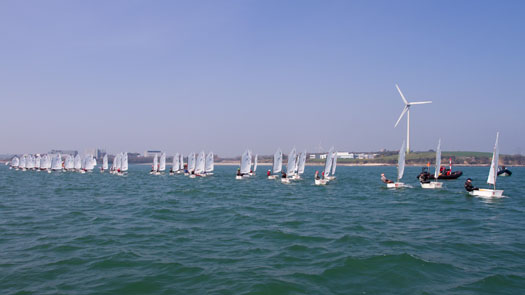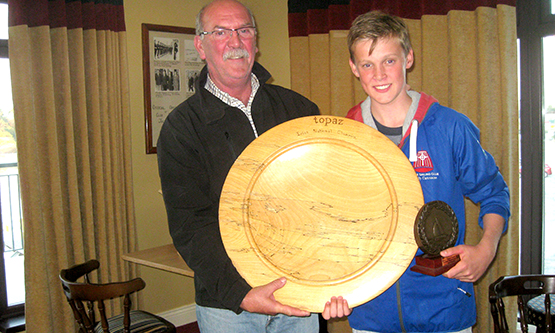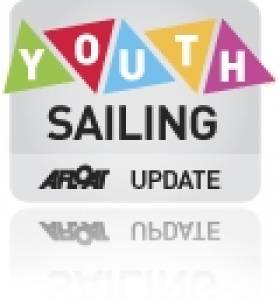Displaying items by tag: youth sailing
ISA Announces Regional Laser Squads
#YouthSailing - ISA Performance has announced its regional Laser squads for the new season.
The Leinster Laser Radial team will comprise Sally Bell, Tara Coveney, Loghlen Rickard, Aaron Rogers, Nell Staunton, Rory and Jenny Fekkes, Patrick Coyle and Rob Salters.
The same province's Laser 4.7 squad includes Hugh Perrette, Peter Fagan, Henry Higgins, Heather Spain, Evie Byrne, Ros Morgan, Greg Arrowsmith and Eoghan Byrne.
Munster's Laser Radials will be sailed by Johnny Durcan, Ronan Walsh, Charlie Moloney, Richard McGinley, Luke McGrath, Jamie Tingle, Billy Duane, Jack Carroll and Eoghan O'Regan.
And Brian Fox, Rebecca O'Shaughnessy, Paddy Cunnane, Chris Bateman, Tom Keal, Cian Jones, Caoimhe Foster and Molly Murphy will make up the Munster 4.7 contingent.
In other ISA youth sailing news, its Optimist squad for 2015-2016 has also recently been announced, while applications for the Topper squad are now open.
McCann & Venner Crowned All Ireland Youth Sailing Champions
Only 3.5 points separated the top three sailors after the medal race of the of the junior All Ireland sailing championships off Kinsale this afternoon. Sailed in Topaz dinghies, Peter McCann of Royal Cork Yacht Club won the Championships with Optimist dinghy champion Peter Fagan of Skerries Sailing Club second. Defending champion Harry Durcan, also of Royal Cork Yacht Club, took bronze. Clare Gorman of the National Yacht Club, Dun Laoghaire was crowned Junior All Ireland Girls Champion. Full results downloadable below.
Youth stars: Nicola Ferguson, Clare Gorman, Peter McCann and Jamie Venner
Top Youth Sailors Head for Kinsale & All Ireland ISA Sailing Championships
Last year's champions Cara McDowell of Malahide Yacht Club and Royal Cork Yacht Club’s Harry Durcan return to defend their ISA All-Ireland Youth Sailing Championships titles in Kinsale this weekend.
The Irish Sailing Association (ISA) received nominations this month from all sailing classes in Ireland for their top sailor to fight it out to become the All Ireland champion. The final entry list is below
Sailing in Topaz dinghies, an eight race series concludes with a medal race on Sunday.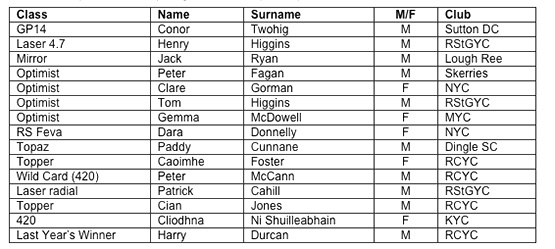
RYA Northern Ireland Youth Sailing Championships at Royal North
Entry to the RYA Northern Ireland Youth Championships and NI Schools Cup closes shortly and the RYA is urging as many youth sailors to enter as possible. Northern Ireland's premier Youth and Junior Sailing event will be hosted at Royal North of Ireland Yacht Club on 26th & 27th September 2015.
The event will offer youth and junior sailors high level competition as well as accessible training and coaching through a RYANI coach supported regatta fleet.
Competitors are invited to race in the Optimist, Topper, Topper 4.2, Mirror, Feva XL fleets if they are under 16 as of 31st December 2015, and may compete in Laser 4.7, Laser Radial and 420 fleets if they are under 19 as of 31st December 2015.
The event will also act as an indicator for all sailors interested in being selected for RYANI Junior and Youth Squads.
Cunnane Retains Topper Topaz Title At Foynes Yacht Club
Last Saturday saw Foynes Yacht Club host the Topper Topaz National Championships on the Shannon Estuary. Five races were scheduled for the one day event with one discard to be applied after the fifth race. ISA National Race Officer Geoff O’Donoghue & Local Race Officer Donal Mc Cormack where presented with a mixed bag of weather conditions which made it a challenge to complete the full schedule.
The thirty one Topper Topaz’s entries were greeted with beautiful sunshine with a twenty minute beat to the sailing area just north of Foynes Island.
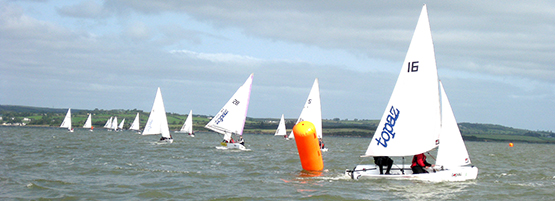
Racing got off to a great start on time in 15kts NNE with wind against tide resulting in choppy seas but great racing. However as forecasted, wind began to ease, and by race three wind had dropped down to 6kts which made it slow and tight racing but which resulted in a few boats not finishing due to pure frustration. Lunch was provided afloat from the mother ships which gave the competitors time to relax and concentrate on the final two scheduled races.
By race four the wind slightly picked again and the fleet in good numbers were back on the race course for two rounds of the triangular course. Going into the final race, it was tied at the top with Brian Fox from Tralee Bay Sailing Club level on points with 2014 champion Paddy Cunnane from Dingle Sailing Club while Mary McCormack from Foynes Yacht Club was just one point behind in third place. At least a thirty degree wind shift during the start sequence meant the start was abandoned and at the restart Brian Fox was deemed OCS. Paddy Cunnane took 1st in the final race and with it the overall championship while a third place for Mary McCormack was enough to secure the runner up spot for her, dropping Brian Fox back to third.
Dingle's Paddy Cunnane retained his title
The club were delighted to have the support of Topper International Ltd who sponsored the overall prizes, Ronstan who sponsored the prizes in the underage categories and UK McWilliams Sailmakers who sponsored a number of individual race prizes.
The Topper Topaz Class Association of Ireland have now nominated Paddy Cunnane for the All Ireland Junior Sailing Championships which will take place in Kinsale Yacht Club on the 26th & 27th September.
Final results:
1st Overall – Paddy Cunnane – Dingle Sailing Club
2nd Overall – Mary McCormack – Foynes Yacht Club
3rd Overall – Brian Fox – Tralee Bay Sailing Club
U16 - Tim Kelleher – Tralee Bay Sailing Club
U14 – Dylan Reidy/Oisín Finucane – Foynes Yacht Club
U12 – Ellie Cunnane – Dingle Sailing Club
Full results can be found attached below
#youthsailing – Youth sailors Peter McCann and Harry Whitaker from Royal Cork took third overall in the 420 dinghy at Kiel week, Germany at the weekend. Douglas Elmes and Colin O'Sullivan of Howth finished fifth overall in the same 154–boat fleet. As Afloat.ie reported earlier, there was also early success for new 29er skiff duo Harry and Johnny Durcan, also of Royal Cork, who finished 11th in their 86–boat fleet.
The youth sailors are returning to Ireland today after the exceptional results at Kieler Woche, one of the largest international regattas in the world with 39 classes and 5000 sailors competing in the week-long event.
Four Irish 420 crews took part in the event, with all four achieving top 10 results over the four days of racing, in the 154-boat fleet.
A nail-biting final two days saw two Irish crews, McCann and Whitaker (RCYC) and Elmes and O'Sullivan (HYC/MYC) swapping places at the top of the fleet, until a disappointing final race for both boats gave Ireland third (McCann/Whitaker) and 5th (Elmes/O'Sullivan) overall.
The event was won by the USA, with France taking second place, and GBR fourth.
For a number of years the Irish Laser sailors have been achieving impressive international results, but in recent years the 420 standard has steadily improved and the Kiel results are being described as a 'major breakthrough' for Irish 420 sailing.
The 420 Munster Championship takes place in Dunmore East next weekend, 4th and 5th July.
#YouthSailing - A once-in-a-lifetime opportunity for young people to sail an Open 60 racing yacht around the Irish coast is now available thanks to MSL Ballsbridge Motors Mercedes-Benz and the Atlantic Youth Trust supporters club.
In total eight places are available for 18–to-24-year-olds to take part in two 'extreme' high-performance coastal voyages on board the Kilkullen Voyager. The boat captain for the voyages will be top Irish solo Figaro helmsman David Kenefick.
The first will see the yacht sail from Dun Laoghaire to Belfast to join the Tall Ships Festival from 29 June to 2 July. The second voyage will leave Belfast on the 5 July and finish in Cork on 11 July to coincide with the Ocean Wealth Conference and SeaFest.
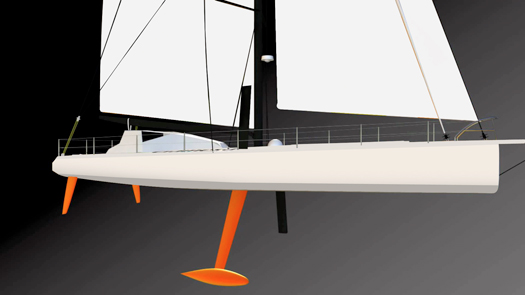
The Kilcullen Voyager is one of the fastest monohull yachts on the water today
Due to the yacht's high performance, sailing experience is required. Conditions on board will be challenging with little to no creature comforts found on other yachts. The benefit is that the Kilcullen Voyager is one of the fastest monohull yachts on the water today.
Speaking about the opportunity, Noel Rabbitte, Mercedes-Benz brand manager at MSL Ballsbridge Motors, said: “We are thrilled to be involved in this exciting, youth development initiative.
"Giving young people this opportunity is comparable to providing a safe environment for young people to drive a Formula 1 car for a weekend with a trained professional in the cockpit.”
No fee is being charged as the yacht has been made available by the Atlantic Youth Trust’s supporters network and the kind support of MSL Mercedes-Benz.
Anyone interested in taking part must submit an expression of interest form (available HERE) by 10am on Friday 26 June.
{youtube}rEbxOEEfeDE{/youtube}
Bcademy Programme For Youth Sailing Prospects Now Underway
#YouthSailing - The Laser Transition Year programme – better known as the Bcademy – is now underway for 2015.
For its sixth year, the programme will comprise a mix of sailing and cycling for the seven youth sailors involved: Patrick Coyle from the National YC, Jack Carroll and Scott O'Sullivan from Kinsale YC, Brian Fox from Tralee Bay SC, and Eoghan O’Regan, Jamie Tingle and Criofan Guilfoyle from the Royal Cork YC.
The journey started at the Royal Cork with loading the trailer and the minibus: eight Lasers, one small RIB, eight bikes and too many bags!
First stop is Brittany, where they will train with a local squad in St Quay and be hosted in local sailors families.
After a week, the group with have a short drive to Crozon for a three-day clinic with the Brittany squad before competing in an Atlantic two-day event.
Next, the group will have a day's drive up to Nieuwpoort in Belgium where they will train a few days before competing at the Belgium Europa Cup event.
Having completed the event, the programme will bring them to Hyeres to compete at the French Spring Nationals.
This final week in Hyeres will be dedicated to fitness to ready the team for the final challenge: a 24-hour cycling relay race in teams of four.
ISA coach Thomas Chaix, who has been running the Bcademy since its inception, says it's "all about developing life skills and independence, improving fitness awareness and of course sailing skills.
"It has been a good feeder for the [ISA] Academy in the past and falls perfectly in the ethos of sailing for life."
Competition Intensifies at Youth Nationals and Optimist Trials
#youthnationals – The Irish Sailing Association (ISA) Pathway Youth Nationals 2015, taking place at Royal Cork Yacht Club are in their second day of competition at Crosshaven writes Claire Bateman. Topper, 420, Laser 4.7 and Laser Radial classes are competing in selection trials for National squads and potential selection for the National Academy. The four-day event also sees the International Optimist Dinghy Association Ireland, 2015 Optimist Trials take place with over 60 entrants.
Today began as a foggy grey day with the breeze more from the south and with a fitful sun trying to break through the clouds like a patchwork quilt on the water later in the day. The wind also increased at this stage going to 16 to 18 knots with a slight hint of west in it. A third Race Committee was called to action under the highly experienced Race Officer David O'Brien of Royal Cork for the 4.7s and the Toppers who were commencing racing today. To a person doing a tour of the three race areas, looking at racing with inner loops and outer loops, separate finish boats, on the water Juries blowing whistles signaling to the unwary, or possibly not unwary, that they had infringed the rules, it all appeared a very competent and slick operation timed to the last. The race team for the 420 and Radials moved further east on the Eastern Bank opposite the Aghada Sailing and Tennis Club where they had to wait a little bit longer for the wind to reach them. When it did it was great to see these fleets surfing on the waves.
In the 420 Class Peter McCann and crew Harry Whitaker from RCYC are the current leaders, followed by Douglas Elmes and Colin O'Sullivan, RCYC/ HYC, while the younger McCann brother James and crew Bill Staunton, RCYC, are in fourth place with Lizziy McDowell and Anna O'Regan from MYC taking the third spot..
In the Laser Radial fleet after six races and one discard Conor Beirne RStYG leads Erica Ruigrok from Rush SC in second followed by Cian Byrne from the host Club in third place.
Meanwhile the 29 boat Topper fleet, having sailed three races, are now led by Geoff Power WHSC, followed by Luke McElwaine from Carlingford Lough, tied on points but with count back putting McElwaine in second place and Caoimhe Foster RCYC taking the third spot.
In the 30 boat Laser Radial Fleet Richard McGinley of the Host Club leads from Ross Morgan SSC, second followed by Rebecca O'Shaughnessy, RCYC 3rd.
In the Optimist 60 boat fleet with Ireland's top sailor Anthony O'Leary as Race Officer the fleet sailed on a traditional Optimist course and had a long day sailing four races bringing their total to seven to date on this weekend which is an Optimist Trials Event confined to sailors who qualified at regional events and the Nationals in 2014. Current leader is Tom Higgins, RStGYC, followed by Gemma McDowell, MYC and Harry Bell, HYC third.
Racing continues tomorrow (Saturday) and tensions are now mounting at this stage of the weekend. Forecast is for fresher conditions and some exciting sailing should be seen throughout the fleets.
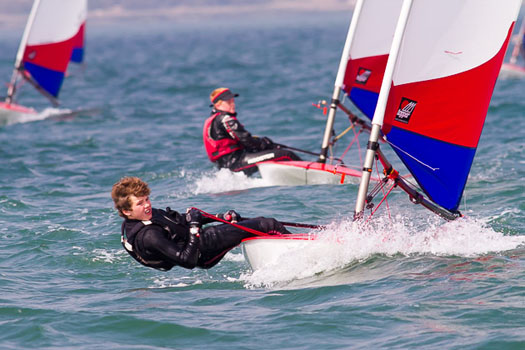
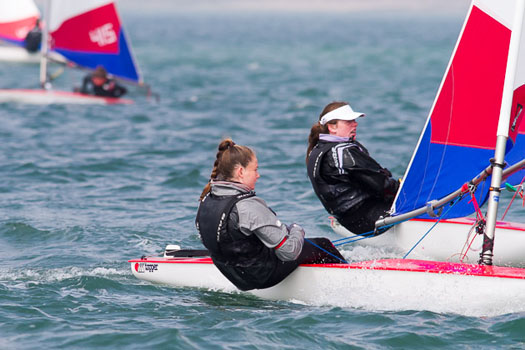
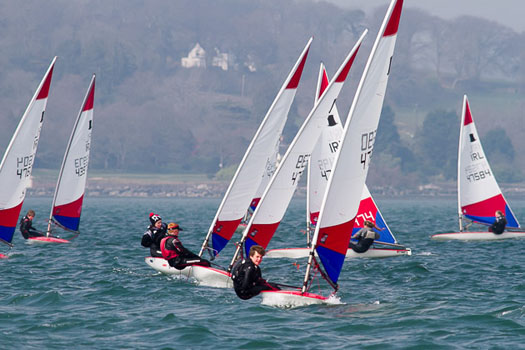
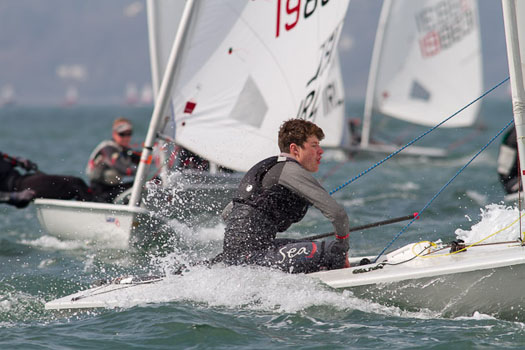
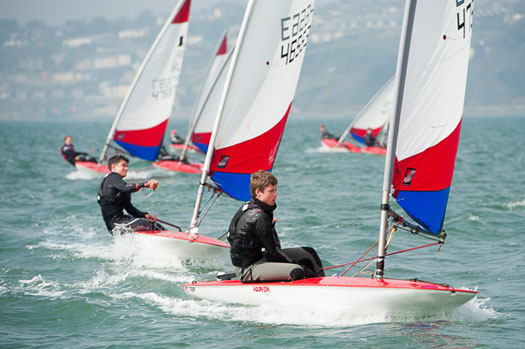
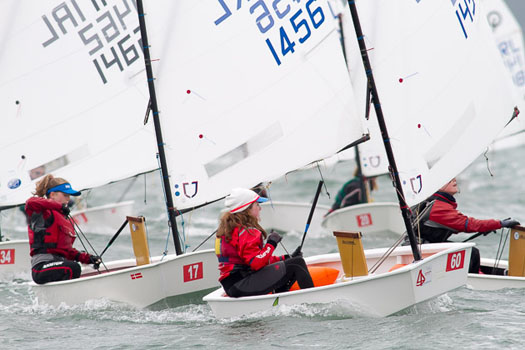
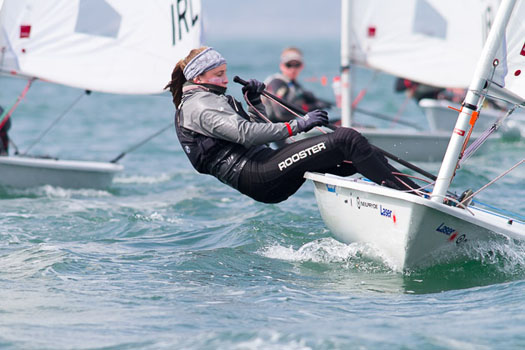
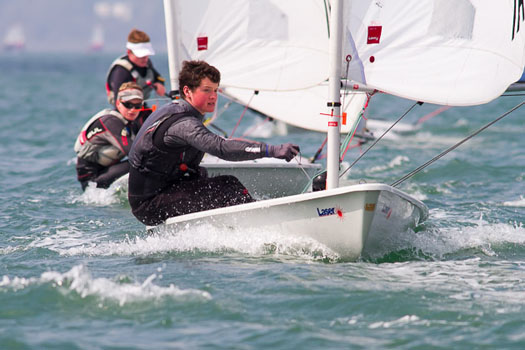
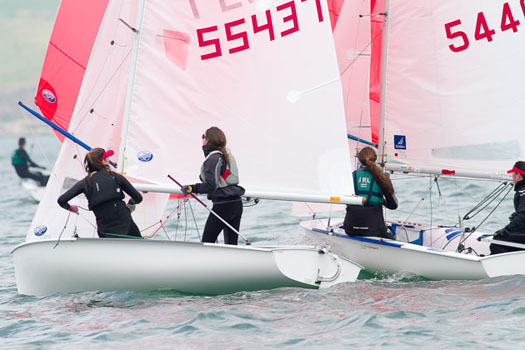
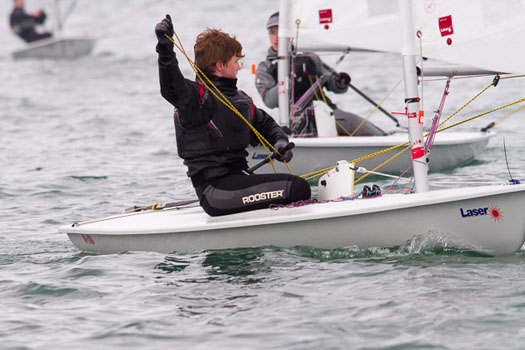
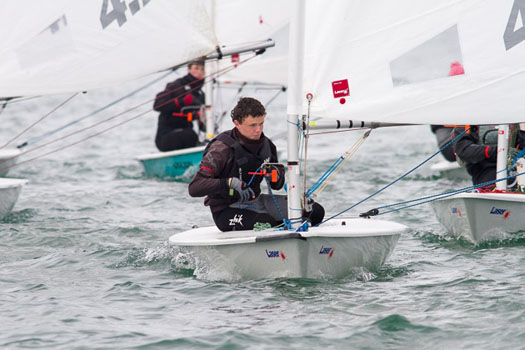
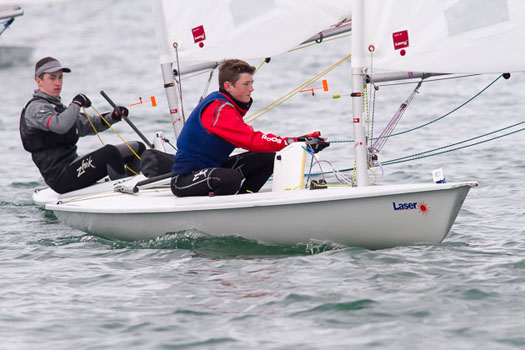



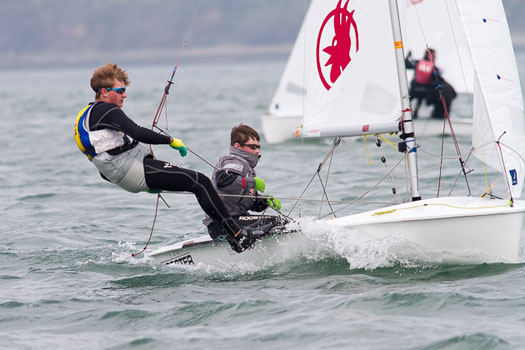
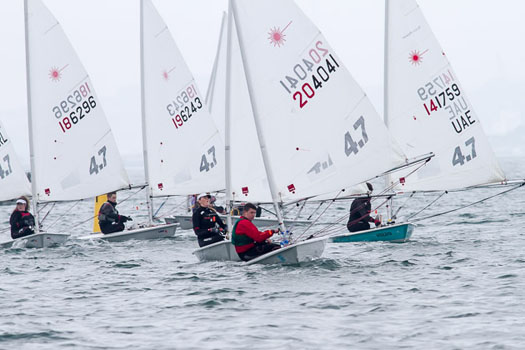

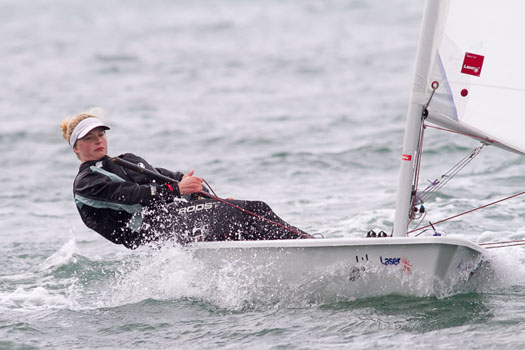
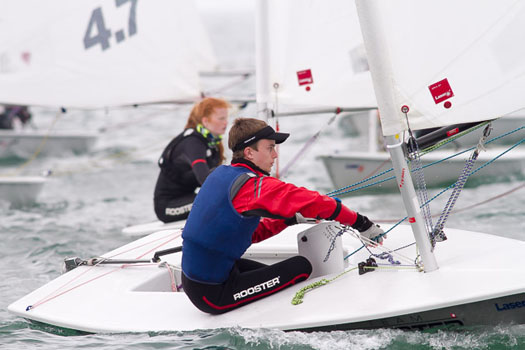
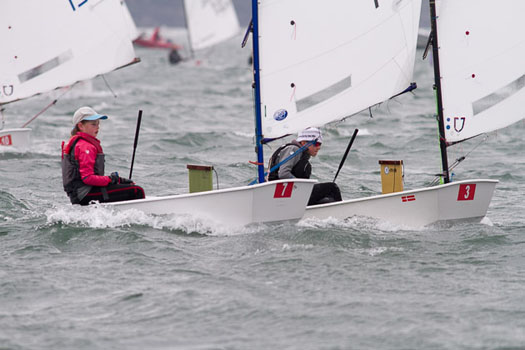
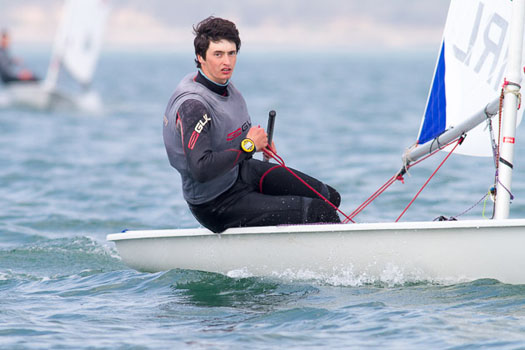
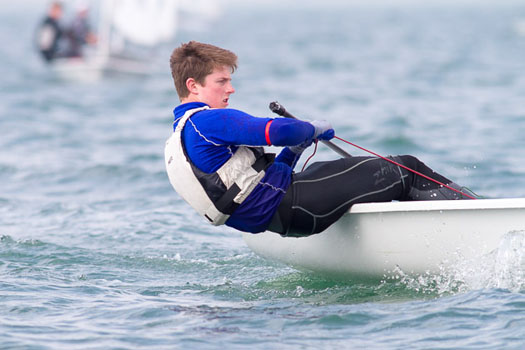


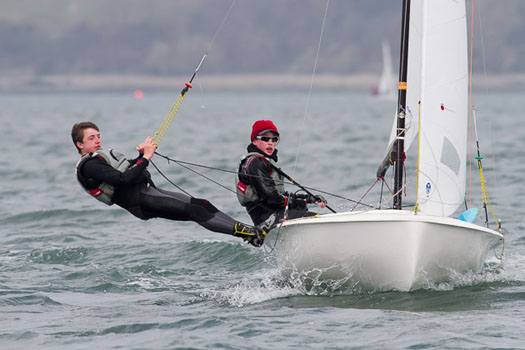
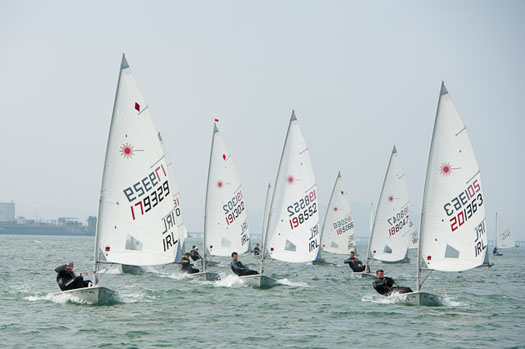

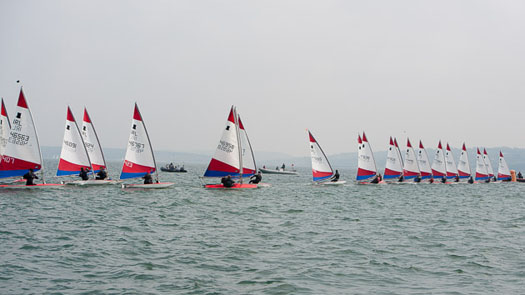
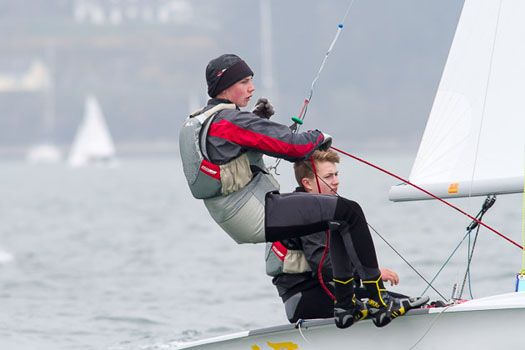

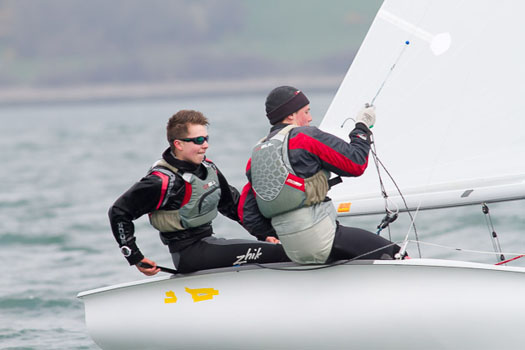
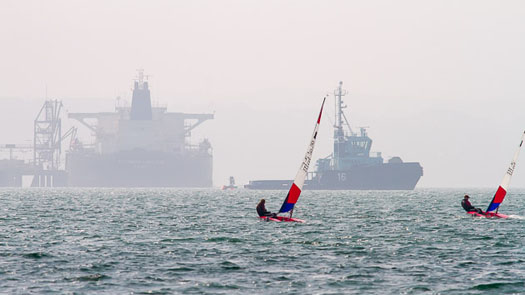
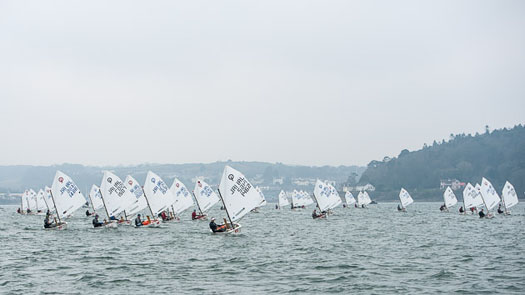
Radials & 420s Start Youth Nationals At Royal Cork
#youthnationals – Today saw the first day of racing at the ISA Pathway Trials and Youth Sailing Championships at the Royal Cork Yacht Club writes Claire Bateman. Today's fleets were Laser Radials and 420s. The Principal Race Officer was Alan Crosbie. The morning turned out to be foggy but there was a light south easterly breeze and the sun made an appearance making it into a pleasant day but still retaining some heat haze.
During the day the wind strengthened slightly and went more into the east with Alan Crosbie weaving his magic by sailing the 420s on the outer loop of a triangular course while the Radials sailed on the inner loop. For the next three days the fleets will be joined by the Toppers and the Laser 4.7s.
Meanwhile, not a mile away on the Curlane Bank, Race Officer Anthony O'Leary was performing his style of magic in enabling the IODAI Optimist Trials also to get in three races. There was no doubt he got the best of the wind from his position as it was somewhat stronger on this course and he got in three fine races for the sixty plus competitors and the races were over forty minutes each for two of them with the third being over fifty minutes.
The IODAI Optimist Trials will run over 4 days from today (Thurs) to Sunday. This is a qualifying event for the Optimist sailors to represent Ireland in 2015 - the top five at Optimist Worlds in Wales, next seven at Optimist Europeans in Poland and a number of sailors chosen for a development team that will sail at the French Nationals.
The 420s and Laser Radials are competing in the ISA Youth Pathway Nationals from today (Thursday,) while the Toppers and Laser 4.7s will compete from tomorrow, Friday to Sunday. Normally this is a qualifying event for the Youth Worlds, which are usually in the summer, but the 2015 Youth Worlds are in Malaysia in December which is a little too far away. Still an important event for all the classes as the Lasers compete for the honour of ISA Youth Pathway Nationals Champion, the 420 sailors are qualifying for the Junior Europeans and Worlds, while the Toppers are qualifying for the ISA Summer squads which will build up their skills for the Topper Worlds in Lake Garda. This is an open event for ALL Topper, 420, Laser 4.7 and Laser Radial sailors, which means the young sailors did not have to qualify to enter and it gives ALL sailors a chance to compete against each other on an even playing field.
All in all an excellent, if somewhat long day for the youth competitors but obviously scintillating and provided for plenty of chatter and camaraderie when coming ashore and bringing their boats back to the allotted compounds for each fleet.
Racing continues tomorrow (Friday).
